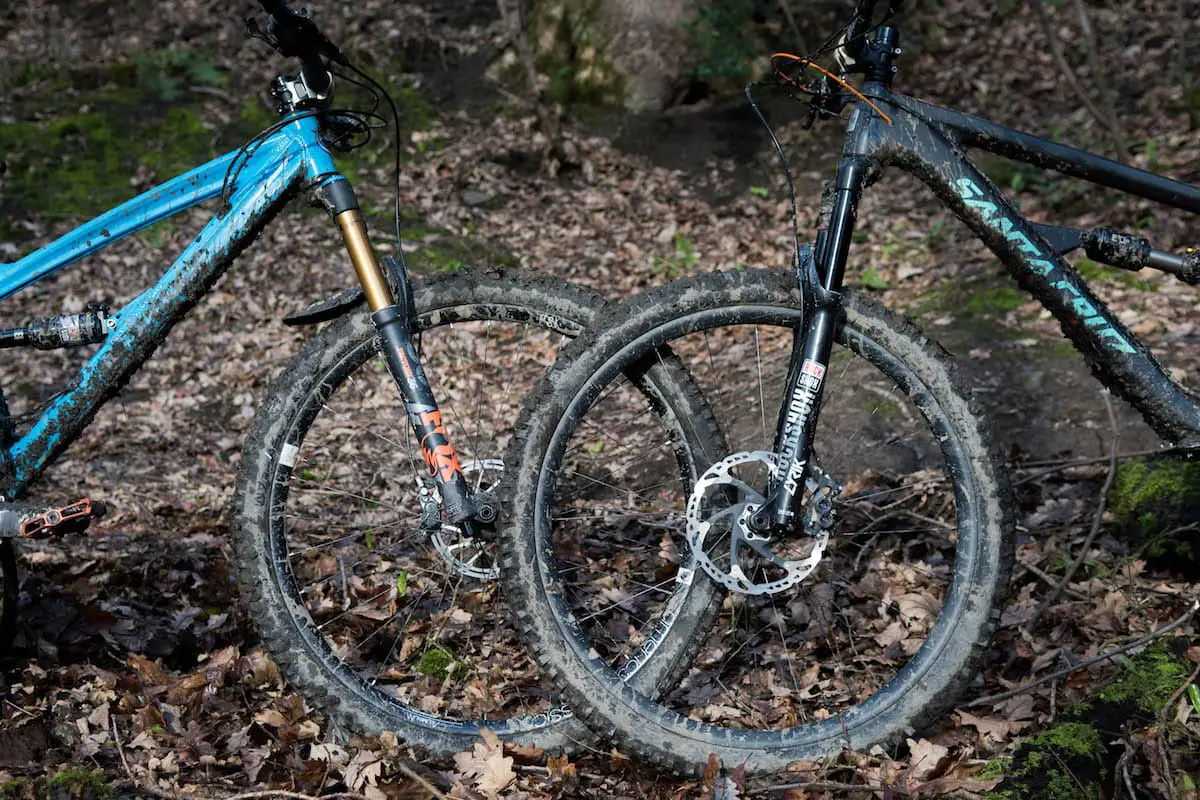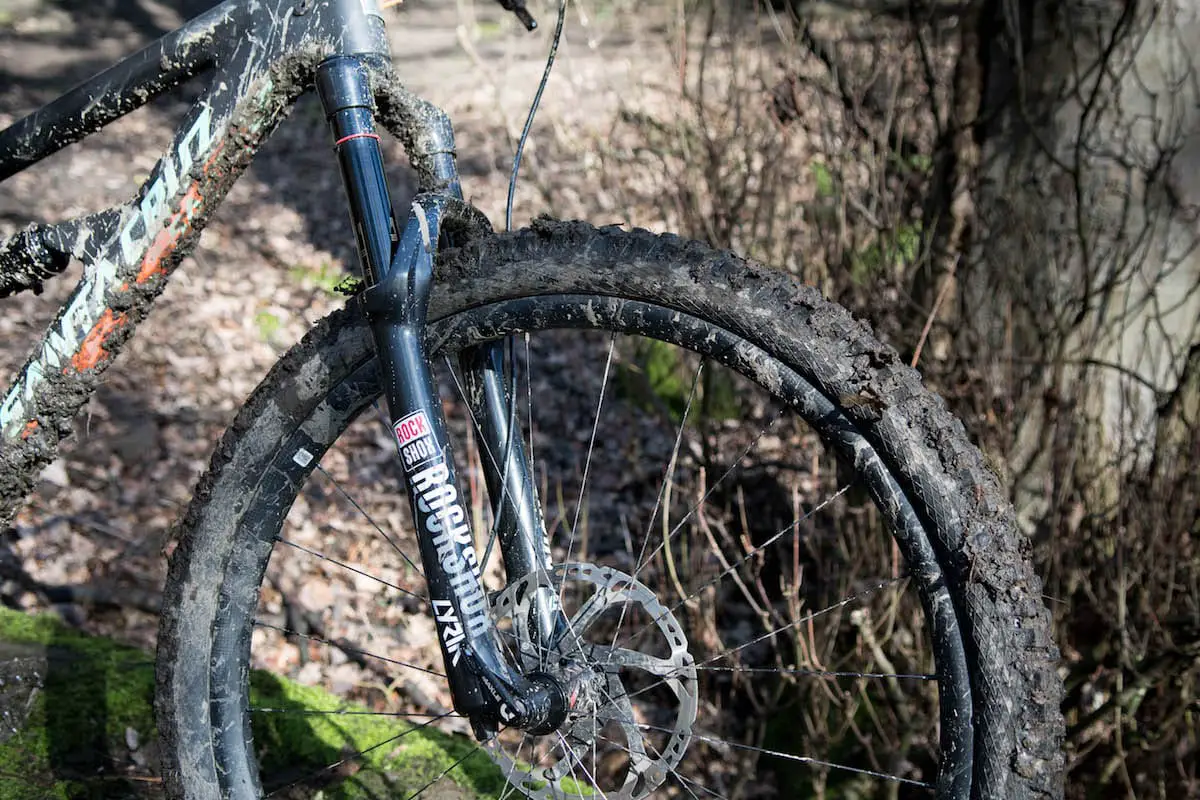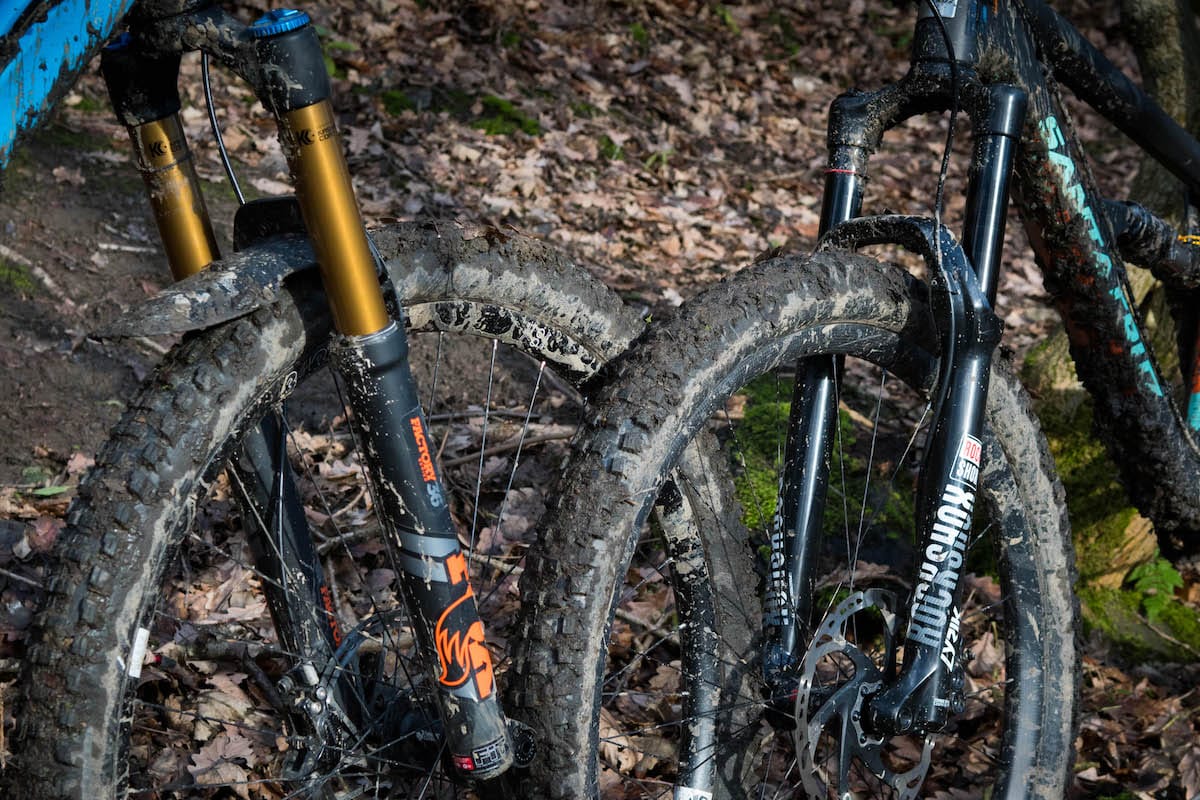Despite mounting opposition in the high-end mountain bike suspension market from the likes of Cane Creek, Öhlins, MRP, Formula and DVO, there is still somewhat of a duopoly when it comes to the fork market. A duopoly made up of two industry titans: Fox Racing Shox and RockShox.
Although the smaller aforementioned brands are gaining solid reputations in the aftermarket, when it comes to OEM, you’re really going to be looking at either one of these forks if you’re buying a long-travel full suspension All Mountain bike. That kind of dominance can only be achieved by many years of consistent performance and market presence. For RockShox, its Lyrik fork has 12 years of experience under its belt, while Fox had the 36 in service as far back as 2005.

With this kind of history behind them, both the Fox and RockShox brands are known quantities for many riders and dealers. Each brand has an extensive global network of wholesalers and tech centres ready to accommodate routine servicing, as well as warranty support should anything go awry. Sure, plenty of riders out there prefer to do the tinkering in their own home workshops, but for a much larger majority of riders, having the necessary backup service and technical support to rely on is more important.
Both Fox and RockShox relaunched their flagship enduro forks for 2018, each featuring new damper and spring technologies (plus a new chassis in the case of the Lyrik). Instead of the usual Bold New Graphics™ that many forks bring out each year, the bonafide changes inside these two 2018 forks have purportedly taken the established performance bar and lifted it up a few notches.
Given those claims, we decided to get one of each fork in their 29er, 150mm travel guise to pitch them against each other to find out which one we reckon is best. It’s worth noting that Barney is much more of a man than me. I am…well, a bit of a pipsqueak in comparison. So given our own very different physical structures, would we come to different conclusions? Below you’ll find a rundown of the specs for each fork, a short summary of both Barney and my experiences of riding each fork back-to-back, as well as a video of each fork to show some of the details up close.

2018 Fox 36 Float FIT HSC/LSC Factory Series Fork Features
- Long-travel 29er trail & enduro fork
- 150mm travel
- 36mm diameter stanchions w/Kashima coat
- Max tyre width: 29×2.5in, and 27.5×3.0in wide tyres
- New Float EVOL air spring
- FIT HSC/LSC damper w/PTFE-based damping fluid
- Adjustments: air pressure, air spring volume, rebound, low-speed compression & high-speed compression
- 110x15mm quick release thru-axle
- 1.5in tapered alloy steerer tube
- Actual weight: 2.02kg
- RRP: £1129
The big difference with the Fox 36 Float fork for 2018 is the addition of an all-new air spring. Called EVOL, this spring concept is borrowed from Fox’s rear shocks, whereby the negative air chamber volume is enlarged to provide a more sensitive beginning stroke. In the case of the 36, the entire spring assembly is actually all-new, and is now essentially a bigger version of what you’ll find in the Fox 34 Float fork. There are fewer dynamic seals, which helps to reduce friction and improve small-bump sensitivity.
Compared to the Lyrik, the 36 uses slightly larger 36mm diameter stanchions (35mm on the Lyrik), though its chassis doesn’t provide as much tyre clearance. You’ll be able to get a 2.5in tyre and some 2.6in tyres (tyre and rim dependent), but not the huge 2.8in plus tyre that the Lyrik will accommodate.
The 36 comes in three trim levels, including an OEM-only Performance model, the Performance Elite version, and the Kashima-equipped Factory Series version. Along with that, the 36 has more damper options than the Lyrik. There’s the base-level GRIP damper option (on the Performance OEM version only), the FIT4 damper (available in both Performance Elite & Factory Series versions), and the one we’ve been testing; the FIT HSC/LSC (Factory Series only). This is possibly one of the biggest advantages that the high-end 36 has over the Lyrik for hard charging riders that want maximum adjustability – it provides independent control of both high and low-speed compression damping.

Fox 36: Wil’s Take
“Small-bump sensitivity is superb. Compared to last year’s 36 fork, the new version is more supple and reactive across a wider range of bump frequencies and velocities. It’s not a massive difference, but it is a noticeable refinement to the action. I’ve often found previous 36s to feel over-damped, but that isn’t the case here at all. The 36 doesn’t quite have the buttery-plushness that the Lyrik oozes, but it is very close, and unwanted stutter vibrations are filtered with ease.”
Fox 36: Barney’s Take
“I prize stiffness above all things, I’m not as overly concerned with small-bump sensitivity, I like forks that sit up and don’t dive – or at least that I can twiddle with to achieve the same effect, and I like to be able to fiddle with high and low speed compression damping. To this end, the Fox 36 served me pretty well straight out of the box. It’s still plenty supple on the little hits, don’t get me wrong, but once tweaked to my taste I found it rode a little higher than the Lyrik we’ve also tested, and it’s plenty stiff, of course – those 36mm stanchions see to that. Bigger hits were handled well; it took unfortunate landings and unexpected high speed rock gardens in its stride, even when high speeds, substantial drops and unexpectedly pronounced cornering combined with my heft.”
Read the full 2018 Fox 36 Float Factory Series fork review here.


2018 Rockshox Lyrik RCT3 features
- Long-travel 29er trail & enduro fork
- 35mm diameter stanchions
- 150mm travel (available with up to 180mm travel)
- Designed for 29in or 27.5+ wheels
- Maximum tyre width: 29×2.8in or 27.5×3.0in
- DebonAir spring (Dual Position also available)
- Charger 2 damper
- Adjustments: Air pressure, air spring volume (Bottomless Tokens), rebound, 3-position compression (open, pedal, firm), low-speed compression in ‘open’
- 110x15mm Maxle Lite thru-axle
- 1.5in tapered alloy steerer
- Actual weight: 2040g
- RRP: £978
Also brand new for 2018, the RockShox Lyrik features a fully redesigned Boost-specific chassis (you can’t get the Lyrik with anything other than 110x15mm dropouts), which is available in 27.5in and 29in versions. The new, wider chassis will allow for up to a 2.8in wide tyre in each wheelsize option, which means with regular 2.3-2.5in tyres fitted, there is a canyon’s worth of mud clearance. For the 29er Lyrik we tested, you can even fit a 27.5×3.0in if you want to go down the fully plus route.
Although the 35mm stanchion diameter is shared with the shorter-travel Pike, the Lyrik’s stanchions are thicker, and so is the crown and steerer too. The extra material adds weight, but more importantly it adds stiffness to the beefy Lyrik chassis – something that RockShox was keen to emphasis for 2018 in its bid to redefine the Pike as the trail fork, and the Lyrik as the burly enduro fork. Compared to the 36, we couldn’t tell any difference in torsional or fore/aft flex between the two.
Internals are all-new, and like the Fox 36, the Lyrik gets a catchy name for its air spring. Called DebonAir, this concept also comes from the rear shock arena, and again it’s all about getting a really supple off-the-top feel to the travel. While RockShox doesn’t rely on a fancy coating for its 35mm stanchions, it still manages to provide a buttery feel for the Lyrik’s action, and in our experience, it’s the smoother operator of the two forks.
RockShox Lyrik: Barney’s Take
“Aesthetics is one thing; performance is quite another. Straight out of the box, I found the fork sat a little lower into its travel than other forks I’ve recently been riding (OK, OK, the Fox 36), and it was incredibly plush from the outset. I had to do a fair amount of tweaking to set things up just so, but there are naturally lots of options to fiddle with – Bottomless Tokens are easy to fit and remove in the workshop, and low-speed compression and rebound are a cinch to fiddle with on the trail. It should only take a couple of rides to dial things in to more or less your specification. As a blank tune, though, the fork seems pretty well set up out of the box.”

RockShox Lyrik: Wil’s Take
“In our little battle between the Fox 36 and the RockShox Lyrik, it was the latter that first fell into my fidgety hands. This worked out well, given that the Orange Stage 5 I was using as a test platform had a 140mm travel Pike RCT3 fitted as standard. Aside from the extra 10mm of travel, this would provide an excellent opportunity to see how the Pike’s bigger brother would fare in direct comparison. In short, the difference was instantly noticeable. While both the Pike and Lyrik forks are smooth, the Lyrik takes things up a notch. It hoovers up hits big and small alike with incredible enthusiasm, putting on a meltingly-good performance in the small-bump sensitivity show. I also found the heavier Lyrik chassis felt noticeably more sturdy than the Pike – both fore/aft and torsionally. These two attributes combine to give the front of the bike just a little more brawn, and that gives you just a little bit more confidence to let off the brakes and wing it. I got away with A LOT on this fork that I really shouldn’t have.”
Read the full 2018 RockShox Lyrik RCT3 fork review here.

Overall
As you’ve probably guessed, these are two very good forks. But the million dollar question remains; which one would we choose?
Barney: “Honestly, it’s a tough, tough call. But I think I’d plump for the Fox 36. That’s not to say that I think the Lyrik is a bad fork; far from it. I’ve been staunchly in the RockShox camp for many years now, and I can find little to criticise. But I like the action of the 36 out of the box; the stiffness is excellent (although I’m not sure I could say to you that it’s any better than the Lyrik) and I like the way it uses its travel. It’s a profoundly capable beast when the going gets lairy; there’s lots of control deep into the stroke, and there’s little binding evident when hard cornering under load. And if I’m being totally superficial (hey, I’ve got to be true to myself) I prefer the look of the Fox. It’s far from overstated, true, but it’s not quite as (how can I put this delicately? Oh, I can’t) dull looking as the Lyrik. Of course, it’s extremely easy to spruce up any fork with fancy graphics these days, but there’s something about the look of the Fox that rings my chimes a little more than the Lyrik does. Of course, it’d look even more bostin’ with an orange lower…”
Wil: “As Barney has already stated, there’s no denying that these are two exceptionally good long travel forks, and I would have no troubles recommending either one of them. While the Fox 36 offers a greater air of refinement – both in terms of its ride quality and from the overall finish of its chassis and adjusters, personally for me, I just cannot go past the incredible sensitivity and small-bump compliance that the Lyrik heaps out in spades. It’s a gloriously smooth performer, and a significant confidence-booster. In many ways it feels like a Pike, just with a little more oomph, and an ever-so-slightly more supple action that you soon miss when you go back to riding a lesser fork. Factor in the cheaper sticker price, ease of service, availability of spare parts, and RockShox’ standard 2-year warranty, and it’s the Lyrik that gets my vote.”
Want to read the full reviews of each fork? Then check out the 2018 Fox 36 Factory Series fork review here, and the 2018 RockShox Lyrik RCT3 fork review here.








Good write up! How do they stack up against the MRP Ribbon though?
No non boost on rs for 2018. Useless. I bought the fox because they still cater for me.